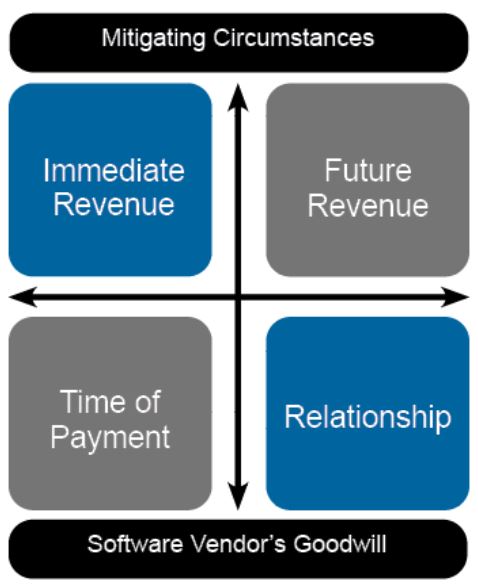Are you shopping for a new place to store your data on the Cloud or are you moving there for the first time? It may be easy to assume that your only options are AWS, Azure, and Google. But while it’s true these giants claim a huge chunk of the marketplace, they are not the only options you have. We’ve put together a who’s who of the top cloud providers outside the Big 3.
Whatever brings you into the Cloud market, there’s something here for everyone. It’s important you pick a provider that gives you a solid solution that is right for you.
At MetrixData 360, we’re in the business of making sure your Cloud migration is smooth and painless with as few unneeded expenses as possible from a software licensing perspective. So, in this article we’ll go over a few of the hottest cloud providers of 2020 who act as suitable alternatives to the big three and see which one is right for you.
Why Go for a Small Cloud Provider?
Bigger is always better right? Not necessarily. Smaller cloud providers have an advantage over the larger cloud providers when it comes to the following areas:
- Customer Relations:
If you’ve ever had a customer service issue to bring up with the large companies, then you’ll know how long they tend to keep you waiting and how little time they have to deal with individual problems. With smaller providers you get to be treated less like a number and more like a person.
- Specialization:
While companies like AWS have their hand in almost everything, smaller companies are allowed to have a more narrowed focus and create the most effective strategy for their unique solution.
- Tailored Services:
- Larger companies tend to have a generic, one-size fits all price. However, since smaller providers usually have to do more to survive, they will often make tailored solutions based on your specific needs, budget, and requirements.
- Innovative Solutions:
Smaller companies need something that makes them stand out and this often leads to innovative products and services.
Top Small Cloud Platforms of 2021
Since Google Cloud, Microsoft Azure, and Amazon Web Services make up more than 50% of the cloud platform marketshare, it’s only natural that they would show up in anyone’s search for a cloud platform. But that market saturation tends to wash out smaller players who can often provide just as much or more value as the big 3, and sometimes at a better rate.
Oracle Cloud
Perhaps a little bit of a late bloomer when compared to its competition like Amazon and Azure, Oracle has still proven to be a reliable product and shows steady growth.
Although Oracle does have a hand in both the PaaS and the IaaS industries, Oracle is primarily a software provider, covering companies that range from small start-ups to enterprises. For this reason, SaaS will be Oracle’s trump card, along with their autonomous database services. Oracle also offers hybrid solutions for their cloud customers.
Pros
- Computing capabilities
- Adjustable storage settings
- Large storage services for low cost
Cons
- Limited integration with other software
- Limited tutorials
- No keyboard shortcuts
Cisco
Cisco has become a collection of multi-cloud products and applications, creating for its customers complete freedom when it comes to workload placement, with its main appeal being Application Centric Infrastructure (ACI). It has partnerships with Azure and AWS, with expected expansion into Google Cloud, proving ideal for multi-cloud deployments and hybrid solutions.
Pros
- Highly secure, open and flexible solution
- Allows you to connect to a large ecosystem of cloud providers
Cons
Kamatera Cloud
Kamatera is known for its low prices in Cloud services and high-performance infrastructure offering reliable performance and unhindered availability, making it suitable for businesses of all sizes.
Kamatera also tempts its customers with tailor-made VPS hosting and offering you full access to their Management Platform features.
In 2018, FinancesOnline awarded Kamatera the Great User Experience and Rising Star awards. Part of what won them those awards are their around the clock, 7 days a week, all year-round tech support (and you’ll talk to an actual human, how exciting!). Their data centers stretch across four continents to provide global support and the promise of 99.95% uptime guaranteed.
Pros
- 100% free 30-day trial with no hidden fees or commitments
- Limitless scalability and storage
- Simplified and user-friendly cloud server management
- Able to add server when required
- Add the database of your choice
Cons
- A few of their customers have noted slower response times
Rackspace
Offering their expertise in several different cloud services, such as dedicated hosting, AWS, Microsoft, and OpenStack, Rackspace has an excellent reputation for innovation and was named the leading hosting provider in Internet Retail for three years in a row.
Pros
- Easy to setup and use
- Both virtual servers and dedicated physical server available
Cons
- Little to offer in the way of shared hosting plan
- While you will always find someone on staff to answer your phone calls, poor customer reviews often complain that employees are undertrained
Alibaba Cloud
Alibaba has really taken off in the Asian markets, acting as the single largest enterprise-only Cloud provider. The Chinese company has a wide array of high-performing services very similar to AWS, including data storage, relational databases, big data processing, content delivery networks, just to name a few.
Pros
- Servers are configured so that websites are totally isolated from one another (one website going down won’t take out the whole server)
- Great range of products for enterprises
- Very detailed in their documentation
Cons
- The regular hosting plan might seem limited (5GB of disk space, 1GM MySQL 5.6 database and 1,000 concurrent connections)
- Despite its global network, Alibaba’s data centers are only located in the US and Hong Kong
- Complicated interface and installers
VMware Cloud Horizon
While perhaps still smaller than the giants of the industry, VMware Cloud Horizon still remains a heavy hitter, with a global network and services that are paired with reasonable prices.
The main benefits of VMware Cloud Horizon is its security, its unified management, its maximum flexibility and its high availability promising 99.99% uptime with confidence.
Pros
- Simplified management, compliance and security
- Device agnostic, suitable for Windows, Macs, Androids etc.
Cons
- Designing architecture can be a confusing task
- Flash management console can be sluggish
- There are no migration paths, which requires you to start from zero
SAP
SAP Cloud Platform has gained a small but loyal fanbase of businesses of all sizes. Its main appeal comes from its high scalability, its top-quality support, and its valuable features like data synchronization and negotiable pricing.
Pros
- SAP and non-SAP solutions can be easily integrated
- Excellent user experience
Cons
- Struggles with API management
- Lacks stability and flexibility
Questions to Ask Your New Cloud Provider
The first step in picking a good partner is asking what kind of services they provide. Many people move to the Cloud for a variety of different reasons: to save money, remove the hassle of managing software architecture on-prem, or to increase your economies of scale.
To know what kind of answer you’re looking for, you’ll need to know what your cloud computing needs are. This will dictate the type of services you’ll require.
Security
You’ll want to know how secure this provider is and their capabilities of storing and protecting your data. Make sure they have standard security measures in place and are constantly striving to improve.
- Do they have firewalls and anti-virus detection?
- What about data encryption and security audits?
Make sure you are completely comfortable in handing over your data.
It’s also a good idea to make sure your Provider adheres to the legislation specific to your industry regarding data management, privacy, and security.
Data Centers
You will want to know where your provider’s data centers are located and if those data centers are compatible with where your company will be working. You will also want to know how safe these data centers are.
- Are they protected from natural disasters, theft, and other events that could result in the loss of your data?
- What will happen if your provider loses your data?
- Will you be compensated for the loss?
- What kind of downtime history do these data centers have, and whether you will be unable to access your data for an extended period?
As the function of your business becomes dependent on your ability to access the internet, ideally this number should be zero. You should also ask what Disaster Recovery solutions they have in place regarding data redundancies.
If you’d like more information on how to properly license for disaster recovery, you can check out our new article: Licensing a Disaster Recovery Environment in Oracle.
Scalability of Architecture
As your business grows, it is important to make sure that your cloud provider can compensate for your growth.
- What is their storage capacity and what sort of additional services will you need as your business grows to new heights?
- And will this provider be able to meet those new demands as they arise?
When it comes to the Cloud, there might be several overwhelming options to pick from, especially when confronted with choosing a provider. Switching providers can be a nightmare, so it’s always best to get it right the first time.
At Metrixdata 360, we have helped many clients successfully migrate to the Cloud with as little expense as possible; we make sure that everything is organized in regard to your licensing so that when you move to the Cloud, you won’t take your compliance issues with you.
If you’d like to learn more, you can check out our Cloud Migration page.









